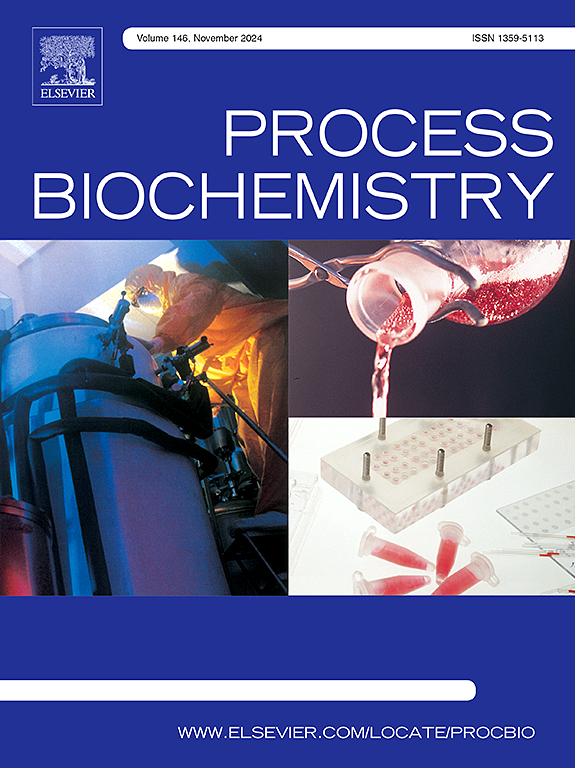Evaluation of culture conditions of Trichosporon oleaginosus DSM11815 for enhancement of growth and lipid production in sugarcane bagasse hydrolysate as a substrate
IF 3.7
3区 生物学
Q2 BIOCHEMISTRY & MOLECULAR BIOLOGY
引用次数: 0
Abstract
In this study, the growth and lipid production of Trichosporon oleaginosus DSM11815 were optimized, and the potential of sugarcane bagasse hydrolysate as an alternative carbon source for culturing the oleaginous yeast was evaluated. The fermentation process in the potato glucose agar (PDA) medium was optimized through single-factor experiments, including initial total sugar concentration, nitrogen source type, carbon nitrogen ratio (C/N ratio), KH2PO4 concentration, fed-batch period, and composition of the fed-batch solution. In the optimized PDA medium, which contained 20 g/L glucose, 7.5 g/L xylose, 0.51 g/L urea, 0.2 g/L KH2PO4, the two-stage culture through fed-batch with T. oleaginosus DSM11815 led to the production of dry weight of 28.2 g/L with the lipid content of 41.1 %. In comparison to the groups of the optimized PDA medium and sugarcane bagasse hydrolysate, the group that utilized sugarcane bagasse hydrolysate to replace half of the optimized PDA medium obtained the highest biomass (39.4 g/L), the highest lipid content (50.00 %), the highest glucose consumption (100 %) and the highest xylose consumption (48 %). The fatty acid composition of all groups mainly consists of long-chain fatty acids of 16 and 18 carbons. These results supported for the utilization of sugarcane bagasse hydrolysate as a cost-effective alternative carbon source.
以甘蔗渣水解物为底物促进生长和产脂的油脂毛孢菌DSM11815培养条件的评价
本研究对产油酵母Trichosporon oleaginosus DSM11815的生长和产脂进行了优化,并对蔗渣水解物作为培养产油酵母的替代碳源的潜力进行了评价。通过初始总糖浓度、氮源类型、碳氮比(C/N)、KH2PO4浓度、补料周期、补料液组成等单因素试验,优化马铃薯葡萄糖琼脂(PDA)培养基发酵工艺。优化后的PDA培养基中,葡萄糖含量为20 g/L,木糖含量为7.5 g/L,尿素含量为0.51 g/L, KH2PO4含量为0.2 g/L,油芽孢杆菌DSM11815补料两段培养,产量为28.2 g/L,脂质含量为41.1 %。与优化后的PDA培养基和蔗渣水解液组相比,用蔗渣水解液替代一半优化后PDA培养基的组生物量最高(39.4 g/L),脂质含量最高(50.00 %),葡萄糖消耗量最高(100 %),木糖消耗量最高(48 %)。所有基团的脂肪酸组成主要由16和18个碳的长链脂肪酸组成。这些结果支持了甘蔗渣水解物作为一种具有成本效益的替代碳源的利用。
本文章由计算机程序翻译,如有差异,请以英文原文为准。
求助全文
约1分钟内获得全文
求助全文
来源期刊

Process Biochemistry
生物-工程:化工
CiteScore
8.30
自引率
4.50%
发文量
374
审稿时长
53 days
期刊介绍:
Process Biochemistry is an application-orientated research journal devoted to reporting advances with originality and novelty, in the science and technology of the processes involving bioactive molecules and living organisms. These processes concern the production of useful metabolites or materials, or the removal of toxic compounds using tools and methods of current biology and engineering. Its main areas of interest include novel bioprocesses and enabling technologies (such as nanobiotechnology, tissue engineering, directed evolution, metabolic engineering, systems biology, and synthetic biology) applicable in food (nutraceutical), healthcare (medical, pharmaceutical, cosmetic), energy (biofuels), environmental, and biorefinery industries and their underlying biological and engineering principles.
 求助内容:
求助内容: 应助结果提醒方式:
应助结果提醒方式:


